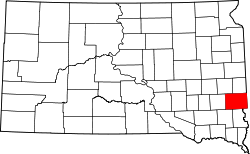External links
Municipalities and communities of Minnehaha County, South Dakota, United States | ||
|---|---|---|
| Cities |  | |
| Towns | ||
| CDPs | ||
| Former cities | ||
| Other communities | ||
| Townships | ||
| Footnotes | ‡This populated place also has portions in an adjacent county or counties | |
| | This Minnehaha County, South Dakota location article is a stub. You can help Wikipedia by expanding it. |